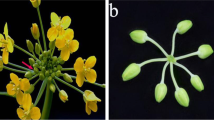Abstract
Isolated Microspore Culture (IMC) is an efficient method to obtain the homozygous strain; however, it is difficult to apply in ornamental kale due to its low rate of microspore embryogenesis. Histone acetylation is an important epigenetic mechanism and may affect the changes of the microspore development pathway, promoting microspore embryogenesis. Here, microspores from three cut-flower ornamental kales, namely Crane Feather Queen (CFQ), Crane Pink (CP), and Crane Bicolor (CB), were treated with the histone deacetylase (HDAC) inhibitor suberoylanilide hydroxamic acid (SAHA) to induce embryogenesis. The haploid ‘CFQ’ microspore plantlets were doubled with colchicine. The results for ‘CFQ’ revealed that, the appropriate concentration of SAHA was 0.03 μM and obtained 17.27 embryos per bud. For ‘CP,’ the appropriate concentration of SAHA was 0.045 μM and obtained 11.19 embryos per bud. For ‘CB,’ the appropriate concentration of SAHA was 0.045 μM and obtained 6.10 embryos per bud. Haploid ‘CFQ’ microspore plantlets were treated with 75 mg/L colchicine for 7 d and the doubling rate was 41.7%. Haploid ‘CFQ’ plantlets were treated with 1000 mg/L colchicine by root-soaking for 4 h and the doubling rate was 64.3%. SAHA could promote microspore embryogenesis, and colchicine root soaking was more effective than adding colchicine to the medium for haploid plantlet doubling in cut-flower ornamental kale.









Similar content being viewed by others
References
Ahmadi B, Shariatpanahi ME, Teixeira da Silva JA (2014) Efficient induction of microspore embryogenesis using abscisic acid, jasmonic acid and salicylic acid in Brassica napus L. Plant Cell Tissue Organ Cult 116:343–351. https://doi.org/10.1007/s11240-013-0408-x
Ari E, Bedir H, Mutlu N (2021) Enhancement of embryogenesis in freshly isolated microspore cultures of ornamental kale through direct cold shock treatment. Sci Hortic 280(6):1–5. https://doi.org/10.1016/j.scienta.2021.109961
Chen W, Zhang Y, Ren J, Ma Y, Liu Z, Hui F (2019) Effects of methylene blue on microspore embryogenesis and plant regeneration in ornamental kale (Brassica oleracea var. acephala). Sci Hortic 248:1–7. https://doi.org/10.1016/j.scienta.2018.12.048
Dai XG, Shi XP, Fu Q, Bao MZ (2009) Improvement of isolated microspore culture of ornamental kale (Brassica oleracea var. acephala): effects of sucrose concentration, medium replacement, and cold pretreatment. J Hortic Sci Biotech 84(5):519–525. https://doi.org/10.1080/14620316.2009.11512559
Feher A, Pasternak TP, Dudits D (2003) Transition of somatic plant cells to an embryogenic state. Plant Cell Tissue Organ Cult 74:201–228. https://doi.org/10.1023/A:1024033216561
Feng H, Yang S, Wang CN, Fu Y (2009) Obtaining and utilization of DH lines in Pakchoi (Brassica rapa L. ssp. chinensis L.). Sci Agric Sin 9:3195–3202
Han S, Guo N, Zhang Y, Zong M, Wang G, Liu F (2018) Researches on the double haploid breeding of ornamental kale (Brassica oleracea var. acephala). J Agric Biotechnol 26(3):521–529
Hoseini M, Ghadimzadeh M, Ahmadi B, Teixeira da Silva JA (2014) Effects of ascorbic acid, alpha-tocopherol, and glutathione on microspore embryogenesis in Brassica napus L. In Vitro Cell Dev Biol 50:26–35. https://doi.org/10.1007/s11627-013-9579-8
Lichter R (1982) Induction of haploid plants from isolated pollens of Brassica napus. Z Pflanzenphysiol 105:427–434. https://doi.org/10.1016/S0044-328X(82)80040-8
Lichter R (1989) Efficient yield of embryoids by culture of isolated microspores of different Brassicaceae species. Plant Breed 103:119–123. https://doi.org/10.1111/j.1439-0523.1989.tb00359.x
Niu RQ, Zhang Y, Tong Y, Liu ZY, Wang YH, Feng H (2015) Effects of p-chlorophenoxyisobutyric acid, arabinogalactan, and activated charcoal on microspore embryogenesis in kale. Genet Mol Res 14(2):3897–3909. https://doi.org/10.4238/2015.April.27.4
Polsoni L, Kott LS, Beversdorf WL (1988) Large scale microspore culture technique for mutation selection studies in Brassica napus. Can J Bot 66:1681–1685. https://doi.org/10.1139/b88-230
Sato T, Nishio T, Hirai M (1989) Plant regeneration from isolated microspore cultures of Chinese cabbage (Brassica campestris ssp. pekinensis). Plant Cell Rep 8:486–488. https://doi.org/10.1007/BF00269055
Wang Y, Tong Y, Li Y, Zhang Y, Zhang J, Feng J, Feng H (2011) High frequency plant regeneration from microspore-derived embryos of ornamental kale (Brassica oleracea var. acephala). Sci Hortic 130(1):296–302. https://doi.org/10.1016/j.scienta.2011.06.029
Winarto B, Teixeira da Siva JA (2011) Microspore culture protocol for Indonesian Brassica oleracea. Plant Cell Tissue Organ Cult 107:305–315. https://doi.org/10.1007/s11240-011-9981-z
Yao Y, Zhang Z, Shan X, Xiao Y, Zhu J (2019) Microspore embryogenesis cytological structures variation and plant regeneration of kale. J Southern Agric 50(5):924–931
Zhang Lu, Zhang Y, Gao Y, Jiang XL, Zhang MD, Wu H, Liu ZY, Feng H (2016) Effects of histone deacetylase inhibitors on microspore embryogenesis and plant regeneration in Pakchoi (Brassica rapa ssp. chinensis L.). https://doi.org/10.1016/j.scienta.2016.05.001
Zhang FL, Takahata Y (2001) Inheritance of microspore embryogenicability in Brassica crops. Theor Appl Genet 103:254–258. https://doi.org/10.1007/s001220100602
Zhou WJ, Hagberg P, Tang GX (2002) Increasing embryogenesis and doubling efficiency by immediate colchicine treatment of isolated microspores in spring Brassica napus. Euphytica 128:27–34. https://doi.org/10.1023/a:1020687517888
Acknowledgements
This work was supported by grants from the National Natural Science Foundation of China (Grant No. 32002070). We would like to thank Editage (www.editage.cn) for English language editing.
Funding
This work was supported by grants from the National Natural Science Foundation of China (Grant No. 32002070).
Author information
Authors and Affiliations
Contributions
J. Ren, H. Feng, C. Liu, and G. Song designed the experiments. C. Liu, G. Song, Z. Liu, J. Zou, S. Dong, and S. Du helped transplant plantlets. C. Liu performed the experiments, conducted the data analysis, and wrote the manuscript. H. Feng and B. Fang revised the manuscript. All authors reviewed and approved this submission.
Corresponding authors
Ethics declarations
Conflict of interests
The authors declare that there are no conflicts of interest in the reported research.
Additional information
Handling Editor: Peter Nick
Publisher's note
Springer Nature remains neutral with regard to jurisdictional claims in published maps and institutional affiliations.
Chuanhong Liu and Gengxing Song contributed equally to this work and share first authorship.
Jie Ren and Hui Feng contributed equally to this work and share corresponding author.
Rights and permissions
About this article
Cite this article
Liu, C., Song, G., Fang, B. et al. Suberoylanilide hydroxamic acid induced microspore embryogenesis and promoted plantlet regeneration in ornamental kale (Brassica oleracea var. acephala). Protoplasma 260, 117–129 (2023). https://doi.org/10.1007/s00709-022-01764-z
Received:
Accepted:
Published:
Issue Date:
DOI: https://doi.org/10.1007/s00709-022-01764-z




